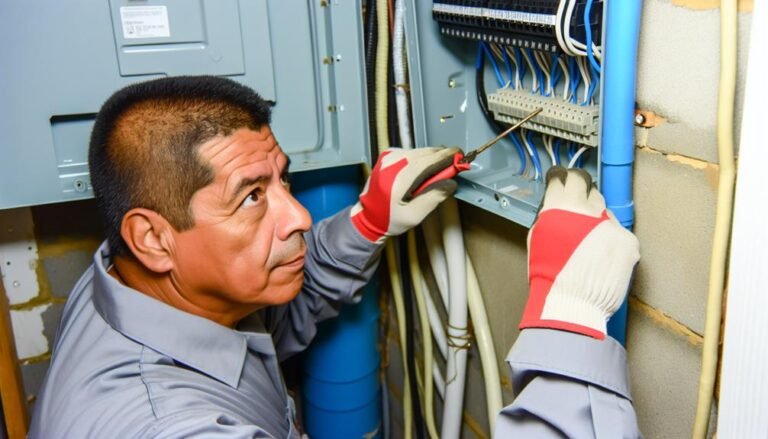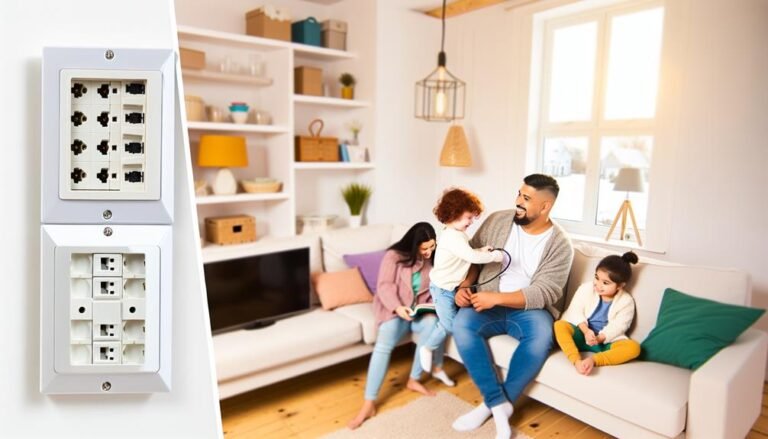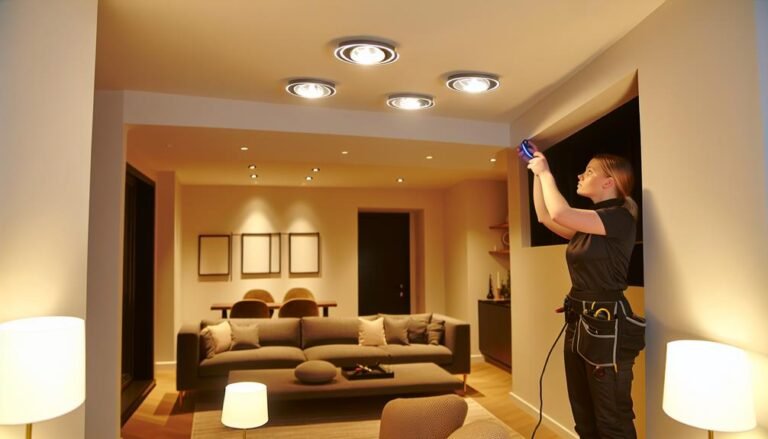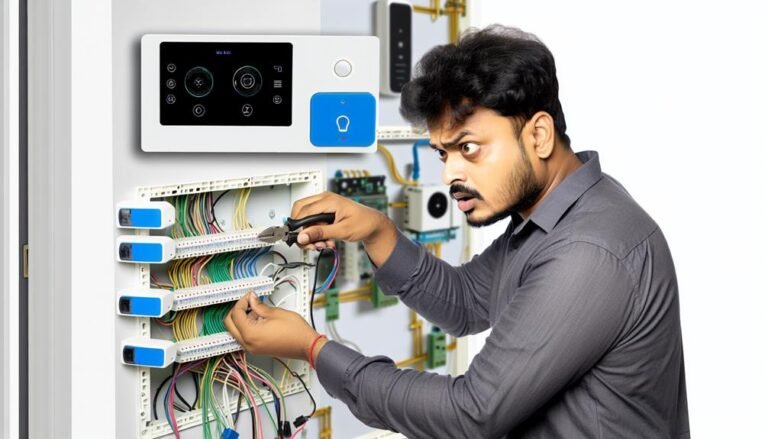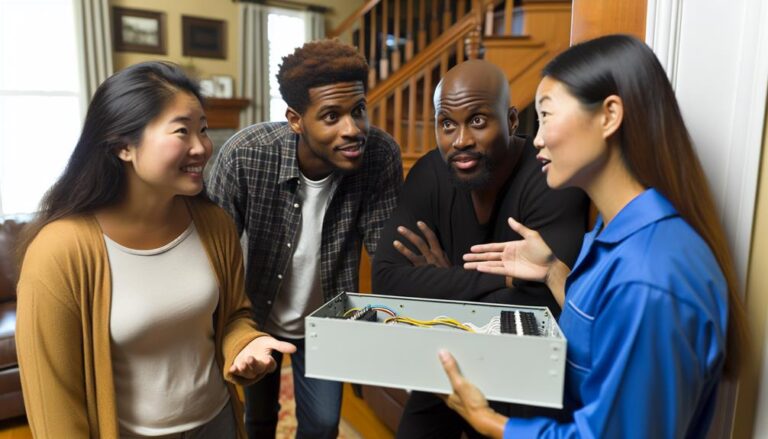Common Residential Electrical Problems and Their Solutions
Did you know that there are common electrical problems that can occur in your home? From flickering lights to non-functioning outlets, these issues can be frustrating and inconvenient.
But fear not, because there are solutions to these problems that can restore your home’s electrical system to its full functionality. So, if you’ve been experiencing any of these issues or simply want to be prepared for potential electrical problems in the future, keep reading to discover the causes and solutions for these common residential electrical problems.
Key Takeaways
- Flickering lights and tripped circuit breakers can be caused by various issues such as loose bulbs, faulty electrical circuits, loose connections, faulty switches, and damaged circuit breakers.
- Non-functioning outlets can be isolated to a single outlet or multiple outlets and can be resolved by checking and resetting the circuit breaker or replacing the outlet if necessary.
- Overloaded circuits can occur due to plugging in too many devices or faulty wiring, and can be identified by frequent circuit breaker tripping and flickering lights. Distributing electrical loads evenly across different circuits can help prevent overloading.
- Faulty wiring can cause flickering lights, frequently tripping circuit breakers, and warm outlets or switches. Promptly addressing faulty wiring is important to prevent electrical shocks and fires, and it is recommended to hire a licensed electrician for inspection and repairs.
Flickering Lights
If you’re experiencing flickering lights in your home, there are several potential causes that you should investigate. Flickering lights can be a nuisance, but they can also indicate underlying electrical problems that need to be addressed.
The first thing you should check is the light bulb itself. Sometimes, a loose bulb can cause flickering. Simply tightening the bulb or replacing it with a new one can solve the issue.
If the problem persists, you may need to examine the electrical circuit. Loose connections in the circuit can cause fluctuations in the power supply, resulting in flickering lights. Inspect the wiring and connections in the affected area and tighten any loose connections.
If the flickering continues, it could be a sign of a more serious issue, such as a faulty electrical switch or a damaged circuit breaker. In such cases, it’s advisable to consult a licensed electrician who can diagnose and fix the problem.
Tripped Circuit Breakers
Tripped circuit breakers can be a common occurrence in residential electrical systems. When a circuit breaker trips, it is a safety feature that is designed to protect your home from electrical overloads. An overload can occur when there is too much current flowing through the circuit, which can lead to overheating and potential fire hazards.
To help you understand the common causes and solutions for tripped circuit breakers, refer to the table below:
| Common Causes | Signs and Symptoms | Solutions |
|---|---|---|
| Overloaded circuit | Lights dimming, appliances not working | Reduce the number of devices on the circuit or redistribute the load |
| Short circuit | Circuit breaker immediately tripping | Identify and fix the short circuit issue |
| Ground fault | Circuit breaker tripping when a device is plugged in | Inspect and repair faulty wiring or appliances |
When a circuit breaker trips, it is important to identify and address the root cause. Start by checking the affected circuit and identifying any appliances or devices that may be causing the overload. If the issue persists, it is recommended to contact a qualified electrician for further inspection and repairs.
Non-functioning Outlets
Non-functioning outlets can be a frustrating and inconvenient problem in residential electrical systems. When you encounter an outlet that isn’t working, there are a few steps you can take to identify and potentially resolve the issue.
First, check if the problem is isolated to a single outlet or if multiple outlets are affected. This can help determine if the issue lies with the specific outlet or with a larger electrical problem. To do this, plug a working device into the outlet to see if it receives power. If it doesn’t, move on to the next step.
Next, check the circuit breaker panel to see if a tripped breaker is the cause. Look for any switches that are in the ‘off’ position or positioned between ‘on’ and ‘off.’ Reset the breaker by flipping it all the way to the ‘off’ position and then back to the ‘on’ position. Test the outlet again to see if it now functions properly.
If the outlet still doesn’t work, you may need to replace it. Before doing so, however, ensure that the power to that specific circuit is turned off at the breaker panel. This will prevent any electrical shocks or accidents while replacing the outlet.
Overloaded Circuits
When dealing with electrical issues in your home, it’s important to address not only non-functioning outlets but also the potential problem of overloaded circuits. An overloaded circuit occurs when too much electrical current flows through a circuit, exceeding its capacity and causing potential hazards.
Here are two key points to understand about overloaded circuits:
- Causes of Overloaded Circuits:
- Plugging in too many devices: Connecting multiple high-power devices, such as air conditioners, heaters, or kitchen appliances, to a single circuit can overload it.
- Faulty wiring: Poorly installed or damaged wiring can cause circuits to become overloaded, especially in older homes.
- Signs of an Overloaded Circuit:
- Circuit breaker tripping frequently: If the breaker trips often or you need to reset it frequently, it could indicate an overloaded circuit.
- Flickering lights: When lights dim or flicker when you turn on certain appliances, it may be a sign of an overloaded circuit.
To prevent overloaded circuits, ensure that you distribute electrical loads evenly across different circuits in your home. Consider installing additional circuits or upgrading your electrical panel if needed. It’s crucial to address overloaded circuits promptly to avoid electrical fires and damage to your electrical system.
Faulty Wiring
Faulty wiring poses significant risks and should be promptly addressed to ensure the safety and functionality of your electrical system. Common signs of faulty wiring include flickering lights, frequently tripping circuit breakers, and outlets or switches that are warm to the touch. These issues may indicate loose connections, damaged wires, or outdated electrical systems. Ignoring faulty wiring can lead to electrical shocks, fires, and damage to appliances and electronics.
To help you understand the potential risks and solutions to faulty wiring, refer to the table below:
| Common Signs of Faulty Wiring | Possible Causes | Solutions |
|---|---|---|
| Flickering lights | Loose connections, damaged wires | Tighten connections, replace damaged wires |
| Frequently tripping circuit breakers | Overloaded circuits, short circuits | Balance electrical load, check for faulty appliances |
| Warm outlets or switches | Overheating wires | Replace outdated electrical systems, check for loose connections |
If you encounter any of these signs, it is crucial to hire a licensed electrician to inspect and repair the faulty wiring. Remember, addressing these issues promptly will ensure the safety of your home and prevent potential hazards. Don’t compromise your freedom by risking the safety of your electrical system.
© 2025 By Electrician Phoenix


